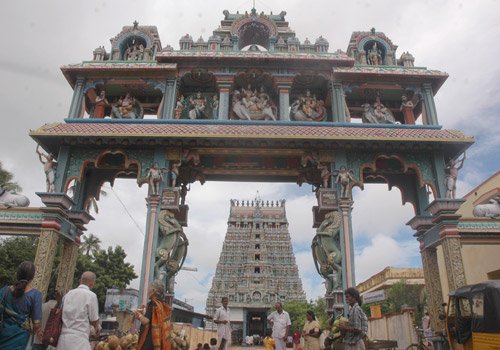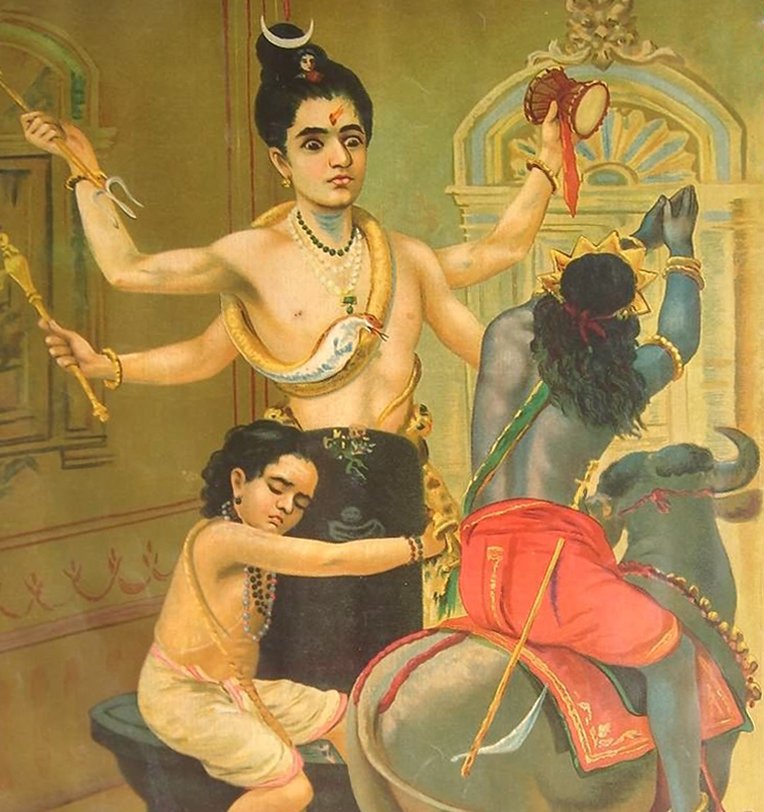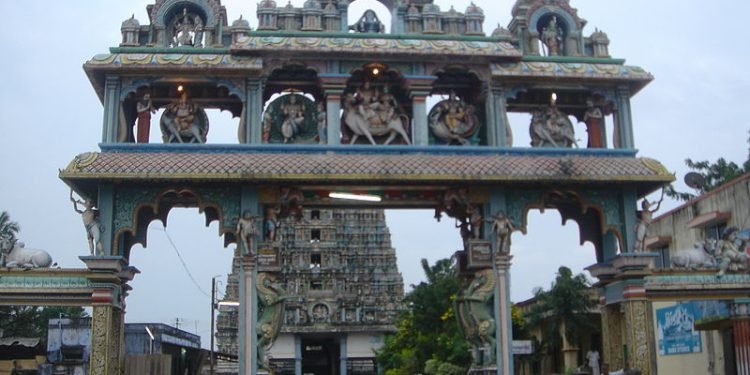Lord Shiva graces in the temple as swayambumurthi. This is the exactly the place where Lord hit Yama the God of death with His legs. Though the presiding deity in the sanctum sanctorum is only one in Linga form, a close look at the Linga will show another reflection of the Linga.
Shrine’s History
Lord Brahma went to Kailash to have the Gnana Upadesa. Lord Shiva gave the seeds of Vilwa tree to Brahma and asked him to sow them in the earth in various places. Where the seed germinates within one hour into a tree shall be a venue of teaching, said Lord Shiva. It happened in Thirukadayur. Shiva the teacher of Brahma is worshipped as Adhi Vilwa Vana Nather in the temple having His own shrine. The Devan began to consume the nectar without offering prayers to Lord Vinayaka who simply hid the pot. They realised their folly and prayed to Vinayaka, got it from Him and placed it in this Thirudayur for Shiva Puja. When opened it was Shiva Linga. As Lord Shiva appeared here as a Swayamnu Linga from the Amirtha-nectar pot He is worshipped as Amirtha Kadeswarar.

Legends Associated with This Shrine
Shortly after the creation of the universe, when the devas and asuras churned the Ocean of Milk to create Amrita, they forgot to worship Ganesha, who is to be worshiped before any great undertaking. Ganesha, hurt and offended at the unintentional slight by the devas, stole the pot of Amrita and hid it at Tirukkadaiyur. While there, Ganesha created a Shiva Lingam, dedicated to his father and mother, and poured some of the Amrita over it. Therefore, it is believed that the Shiva Lingam in this temple has the power to grant longevity to its worshipers. For this reason, the Shiva Lingam at this temple is known as Amrita Ghat Eshwarar, which, translated from Sanskrit literally means “Lord that leads to immortality”. It is also believed that Abhirami incarnated here by the power of Vishnu.
Markandeya Long ago, near the temple of Tirukkadaiyur, there lived a sage named Mrikandu and his wife Marudmati. They were both devotees of Lord Shiva and worshipped him day and night for many years, asking to be graced with a child. After many years of penance, Shiva appeared to Mrikandu and Marudmati. He told them that he heard their prayers and would give them a choice: they could either have a gifted son who would live to be only sixteen, or a son of low intelligence who would live a long life. Mrikandu and Marudmati chose the former and were blessed with Markandeya, an exemplary son, destined to die at the age of sixteen. As Markandeya grew, so did his devotion to Lord Shiva. As advised by his father, Markandeya worshipped the Shiva Lingam at Tirukkadaiyur, even bringing water from the Ganges to the temple via an underground passage. On the day he was destined to die, Yama, the deity of death, appeared with his noose to tie around the soul of Markandeya and drag it to the hell. Markandeya sought refuge in the Lord and embraced the Siva Lingam. Lord Shiva appeared and warned Yama not to touch Markandeya, as he was under his protection. Yama refused to listen and threw the noose anyway, binding Markandeya and the Lingam together. Angered by Yama’s extraordinary arrogance, Lord Shiva kicked him and held him under his foot, making Yama inactive. Markandeya was blessed by Lord Shiva to remain sixteen years old eternally. It is for this reason that Lord Shiva is also called “Kala-samhara” at this temple. Meanwhile, with Yama being rendered inactive, there were no deaths on earth, but people were still being born. Burdened by the weight of so many people and unable to sustain their hunger, the earth-goddess, Bhumi Devi, appealed to Lord Shiva for help. Lord Shiva, feeling compassionate for the earth-goddess, released Yama, allowing death to occur again. However, in order to remind Yama never to try to kill someone while they are worshiping Shiva again, the icon of Lord Shiva in this temple depicts the Lord with his forefinger raised in warning. Since it is believed that Lord Siva subdued Yama in Thirukkadaiyur, the Lord is called Mrityunjaya.

Architectural Relevance of This Shrine
The temple, in line with the temple architecture of the Chola dynasty, occupies a very vast area of 11 acres, with five courtyards, several imposing temple towers, and large and spacious mandapas. Though the details of the king who consecrated the temple are uncertain, it can be ascertained from inscriptions in the temple that it has been in existence since at least the tenth or eleventh century, during the reign of Raja Raja Chola I. It was during the period of Kulothunga Chola I that the brick walls of the temple were replaced with stone walls and the mandapam in the front was constructed. The rajagopuram, or the front entryway of the temple, is replete with images made of mortar, depicting various legends associated with the temple. There are three temple tanks, or teerthams, known as ‘Amrita Pushkarini’, ‘Kaala Theertham’ and ‘Maarkandeya Theertham’. There is a separate shrine dedicated to Abhirami. The Shakta saint Abhirami Pattar is believed to have rendered the Abhirami Anthathi in the front hall of the shrine. The temple also maintains a separate shrine for Markandeya worshipping Kalasamhara Murti. Although Thirukadaiyur is a Shaiva temple, it contains an old Vaishnava temple. The gods in this temple are Amrita Narayana and his consort Amrita Valli (Lakshmi).

Shrine’s Map Location and How to Go There
By Road
You can easily get regular buses to Thirukadaiyur from other major cities of the country Thirukadayur.
By Rail
Thirukadaiyur does not have a train station.The Nearest option is Karaikal 85 km away.
By Air
There are no regular flights from other major cities of the country to Thirukadaiyur. The Nearest airport is Pondicherry Airport 85 km away.
Shrine Timings
6.00 a.m. to 1.00 p.m. and 4.00 p.m. to 9.00 p.m.
Events Celebrated at This Shrine
Worship is offered six times a day at this temple. Almost every day at the temple begins with one celebration or other, as hundreds of pilgrims throng the temple to celebrate their sixtieth or eightieth birthdays. Based on the legend of Markandeya, it is believed that worshipping at this temple will give longevity to couples who have reached age sixty or eighty-one. A service called Sashtiaptha poorthi is celebrated in honour of a husband’s sixtieth birthday and Sadhabishegam is celebrated in honour of his eighty-first birthday. The annual Brahmotsavam is celebrated in the month of Chithirai (AprilMay) here. The Shankha-abhisheka, a festival of the Divine Mother celebrated in the month of Kartikai (NovemberDecember), is also of great importance here. Other festivals celebrated at this temple in honour of the Divine Mother include Navaratri and Aadi Pooram, a festival celebrating the day that Abhirami attained her menarche.













































